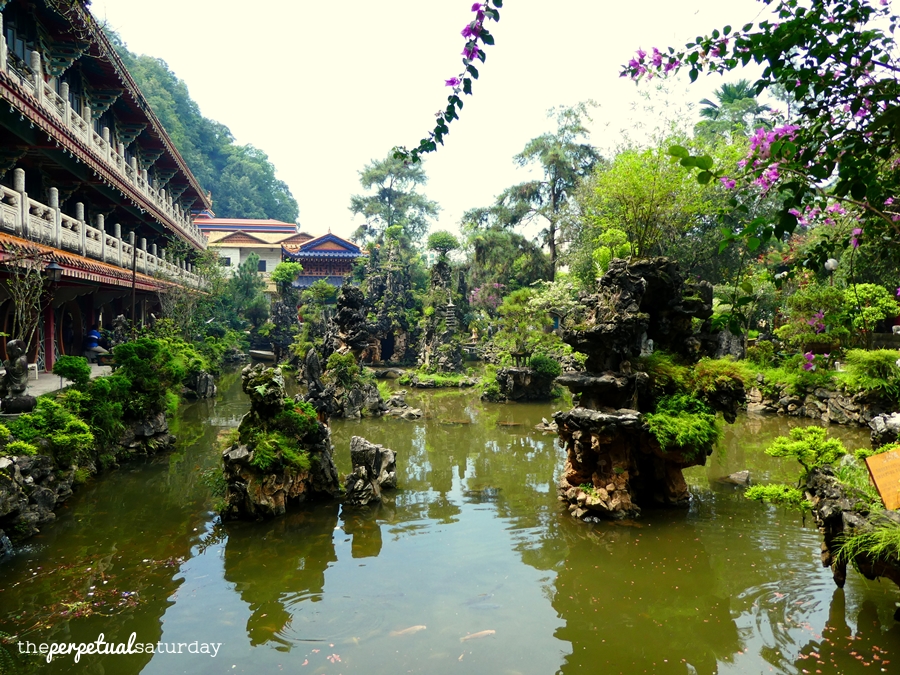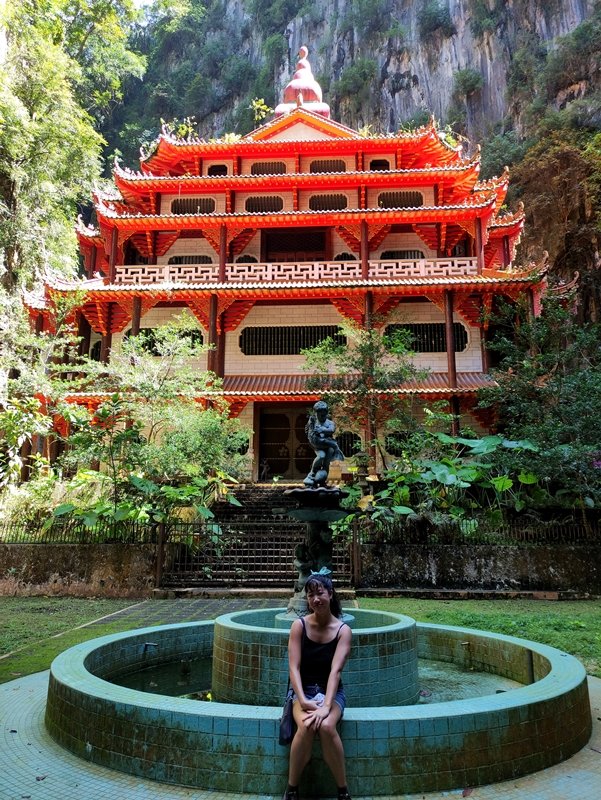The most touristy of the three temples, Sam Poh Tong is a bit overrated for its reputation as one of “the best” things to do in Ipoh.

Any visitor to Ipoh will be advised to visit at least one of the three temples southeast of central Ipoh: Sam Poh Tong Temple, Nam Thean Tong Temple, and Ling Sen Tong Temple.
This cluster of temples is an ideal place to experience the Taoist and Buddhist religions. Not only are they within walking distance of each other, but these cave temples each have their distinct style so you don’t get bored of seeing the exact same thing three times. Since these are functional temples, admission is completely free for all three.

Sam Poh Tong Temple is the most famous of the three. It consistently makes its way onto “Best Things To Do In Ipoh” lists while the others get overlooked. Its distinction as the oldest cave temple in Ipoh and supposedly the largest cave temple in all of Malaysia draws in flocks of locals and tourists alike.
Getting Here & Parking
Sam Poh Tong is located around the bend on the narrow winding road. While the first two temples were a stone’s throw away from each other, the distance to Sam Poh Tong is slightly further. The outer gate is rather simple compared to the other temples and looks like it might be easy to miss, but you will be able to identify that you’re here by the crowds.
If you drove here, you can simply park for free on the road just outside the temple. If, however, you are visiting on a busy period such as on Tomb-Sweeping Day or during the Chinese New Year season, there will be a manned lot set up in the field across the street. I think I remember the parking fee being RM10 per car during CNY in 2017.
Food & Drinks at Sam Poh Tong
At the outer gate, there will be a cart with an old couple selling cold drinks and some dry snacks like chips. Whether Sam Poh Tong is the last temple of your visit or the first, it’s not a bad idea to pick some refreshments. These temples are located on a plain where, for most of the day, there’s no reprieve from the blazing sun. Don’t worry, you are allowed to have drinks inside the temples. The cart’s beverages are reasonably priced at RM3 to RM5 for bottles of sugar cane juice or coconut water with flesh in a takeaway sippy bag.
To the right of the main arch, watch for signage pointing to the on-site restaurant. If this is your first temple of the three and you’re already starving, you should get something to eat here. Neither of the other two temples has any food whatsoever, and it’s almost a kilometre to the nearest restaurant, which are a couple of fast food joints to the north just off the highway. The Sam Poh Tong restaurant is completely vegetarian, and the dining room is somewhat dark and cavernous. The food is very simple cuisine that adheres to Buddhist principles. Expect dishes like sauteed veggies, tofu dishes, plain rice and the like. It’s not the most satisfying food, but it will fill you up until you can get somewhere with beers and greasy burgers.
What To See at Sam Poh Tong
Paifang & Temple

After walking along a simple bridge, the commanding Sam Poh Tong arch heralds the temple entrance. The blues and reds have been baked by the sun and are not much darker than the white marble columns. You will see how bright the colours used to be if you check out the back of this paifang. While you’ll be busy looking up, don’t miss the opportunity to look at the carvings on the balustrade on the steps before you enter the temple!

The main sanctum is surprisingly small and narrow. Inside, the caveyness has been toned down with linoleum floors and walls that have been plastered in an odd colour. Large deity statues and Buddhas are behind glass, while smaller ones will sit freely on altars. There are lots of statues for visitors to seek out, including the ones on the second floor. The staircase is located just inside the entrance of the cave, on the side.
Scenic View
You may have read about some 246 stairs at Sam Poh Tong that lead to a roof where you can get a scenic view of Ipoh. Honestly, I don’t know when the hell anyone was ever able to get up to this spot. I have been to Sam Poh Tong in 2017 and again in late 2020 and there was never an option to get up to where ever this rooftop view is. The staircase that might have led up to this viewing spot was behind metal gates that looked like they had been locked for years. If you’re reading this post well past the publish date and are hoping that “maybe” it will be open by the time you visit, then good luck to you. Tell me in the comments if/when it’s finally open!

The only view is from the second floor, which is accessible from the stairs I mentioned above. Once you get onto the balcony, the archway blocks most of the view of the temple grounds below. However, this is a good spot to get a closer look at the backside of the paifang which is as intricately decorated as its front. In the distance, you will only be able to see trees and the cliffs. Once you go back inside, you will also be able to look down at the main chamber from your vantage point. It is normally possible to get into further upper sanctums from here, but this was closed off during our last visit, probably due to COVID.
Turtle Pond Courtyard
Sam Poh Tong is sometimes colloquially named “the turtle temple” for the booming turtle population living within.

There is a short, low ceiling tunnel that leads into a chamber flooded with natural light. This enclosed valley is where you’ll find two of the main attractions of Sam Poh Tong. Around the periphery will be a few slab carvings and statues. The red pagoda is the centrepiece, its colours bright against the grey cliffs. Truly looking like the sacred place that it is, if you come here around noon on a sunny day, the light streams in and illuminates the pagoda in a holy glow. This red shrine has always been closed every time I’ve visited, so it is purely there for a pretty picture.

The tortoise pond is surrounded by a metal fence. There is lots of space between the bars so you can get a good look at the hundreds of creatures in this busy turtle metropolis. It’s an open space with only a sun shelter, but otherwise, nothing to obstruct your view except for the murky surface of the pond. The pond in the enclosure looks pretty gross, and it’s likely the cause of the few mosquitoes around. It might be depressing for animal lovers to see the tortoises living in a bare and filthy space, but they are revered and well-fed here at Sam Poh Tong, so it’s not all bad.
Back at the entrance to the temple, you can buy small tubs of turtle food for about RM5, which will consist of chopped veggies. You may end up starting a bunch of turtle fights, but toss them into the enclosure to see them move as fast as tortoisely possible to get a piece. It’s fun and it is said to bring some good luck to feed these turtles – if you believe in luck.

Maybe it’s just me, but I find the turtles to be so cute. The way they crane their necks around, climbing on top of each other or slowly scraping themselves across the stone bricks, it’s so charming. I honestly think I spent forty-five minutes watching them during our visit.
Temple Garden

Out on the grounds is Sam Poh Tong’s fish pond where you can walk around its entire periphery. This garden won the award for “Best Landscaped Garden in Malaysia”… back in 1993. A plaque bragging about the decade’s old win is set up at the water’s edge. Apparently, winning once was enough and the temple doesn’t seem to strive too hard to win the honour again. The water is pretty brown, but this lake garden has fascinating rock formations with miniature statues and paifangs hidden in the alcoves. At the far end, there’s a large floating shrine big enough to enter… but of course it’s locked up.

Facilities at Sam Poh Tong
The Temple Garden is where you’ll also find Sam Poh Tong’s washrooms that are free to use. On the side of the lake that is next to the long building, you should notice a concrete corridor that looks sort of like a parking garage. Follow this to the end and turn left. Despite Sam Poh Tong having the most visitors (and presumably, receives the most donations), the state of the toilets do not match its stature. The washroom is one large concrete shack with the squatters (there are no sitting toilets) in their own dark, enclosed room. There’s no toilet paper or even a hook to hang your bag on in these cubicles. Place your rucksack on the lawn outside and have a buddy watch it if you can. There is one sink to wash up at, but there is no soap or hand towels provided.
When To Visit Sam Poh Tong
Sam Poh Tong has irregular hours compared to the other two temples. The official admission times at Sam Poh Tong are listed as 7:30 am to 2:30 pm, but I’ve read from other sources that the hours are from 9ish until 4 pm or even 6 pm. I would guess that the temple is probably open late on busy, auspicious holidays. On an average day, you can’t go wrong if you visit between 9 am and 1 pm, so try to schedule your visit during that period. My estimate is around 30 minutes to see this entire temple, but it depends a lot on how much you enjoy watching turtles.
Saturday Worthy?

Top Ten listmakers obviously love this place, but even Ipohites seem to share this preference for Sam Poh Tong. During my first visit to Ipoh, my cousin only took me to see this temple. He claimed that the other two weren’t worth seeing, despite their close proximity. If you have lots of time in Ipoh, Sam Poh Tong and the other two temples are a couple of hours well spent.
I do feel that the mindset surrounding Sam Poh Tong is “it’s old, so it must be good”. Considering how many visitors it gets on a daily basis, Sam Poh Tong should have much better maintenance. Its rundown appearance and general uncleanliness make this temple feel overrated and not the best cave temple in Ipoh that every blog says it is. The history is deeper at Sam Poh Tong if you’re into that. However, if you’re interested more in visuals, go to Kek Look Tong. No one has even heard of this temple, but it is much more impressive and well-kept in my opinion.
Sam Poh Tong Temple Info
Admission: Free (donations appreciated)
Parking: Free (~RM10 fee applies on special occasions)
Hours: 7:30am – 2:30pm
Washroom On-Site: Yes








Comment on “What To See at Sam Poh Tong Temple in Ipoh”